Abstract
Molecular imprinting of morphine and the endogenous neuropeptide [Leu5]enkephalin (Leu-enkephalin) in methacrylic acid-ethylene glycol dimethacrylate copolymers is described. Such molecular imprints possess the capacity to mimic the binding activity of opioid receptors. The recognition properties of the resultant imprints were analyzed by radioactive ligand binding analysis. We demonstrate that imprinted polymers also show high binding affinity and selectivity in aqueous buffers. This is a major breakthrough for molecular imprinting technology, since the binding reaction occurs under conditions relevant to biological systems. The antimorphine imprints showed high binding affinity for morphine, with Kd values as low as 10(-7) M, and levels of selectivity similar to those of antibodies. Preparation of imprints against Leu-enkephalin was greatly facilitated by the use of the anilide derivative rather than the free peptide as the print molecule, due to improved solubility in the polymerization mixture. Free Leu-enkephalin was efficiently recognized by this polymer (Kd values as low as 10(-7) M were observed). Four tetra- and pentapeptides, with unrelated amino acid sequences, were not bound. The imprints showed only weak affinity for two D-amino acid-containing analogues of Leu-enkephalin. Enantioselective recognition of the L-enantiomer of phenylalanylglycine anilide, a truncated analogue of the N-terminal end of enkephalin, was observed.
Full text
PDF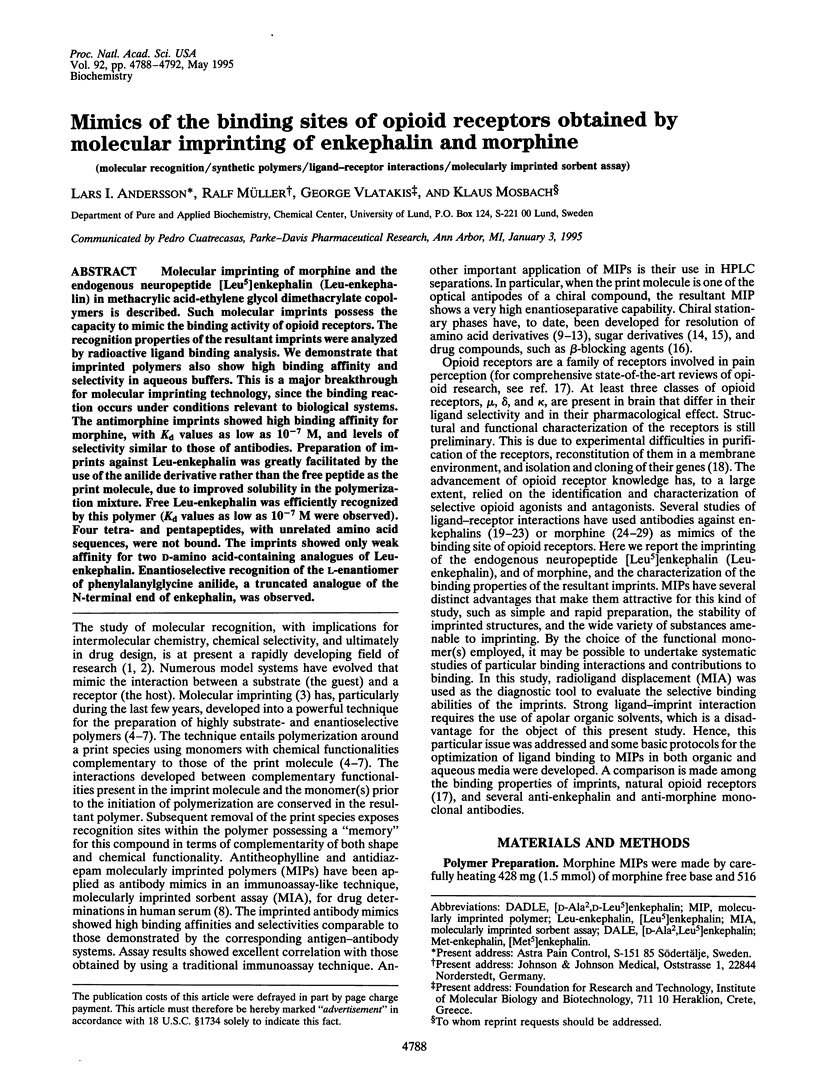
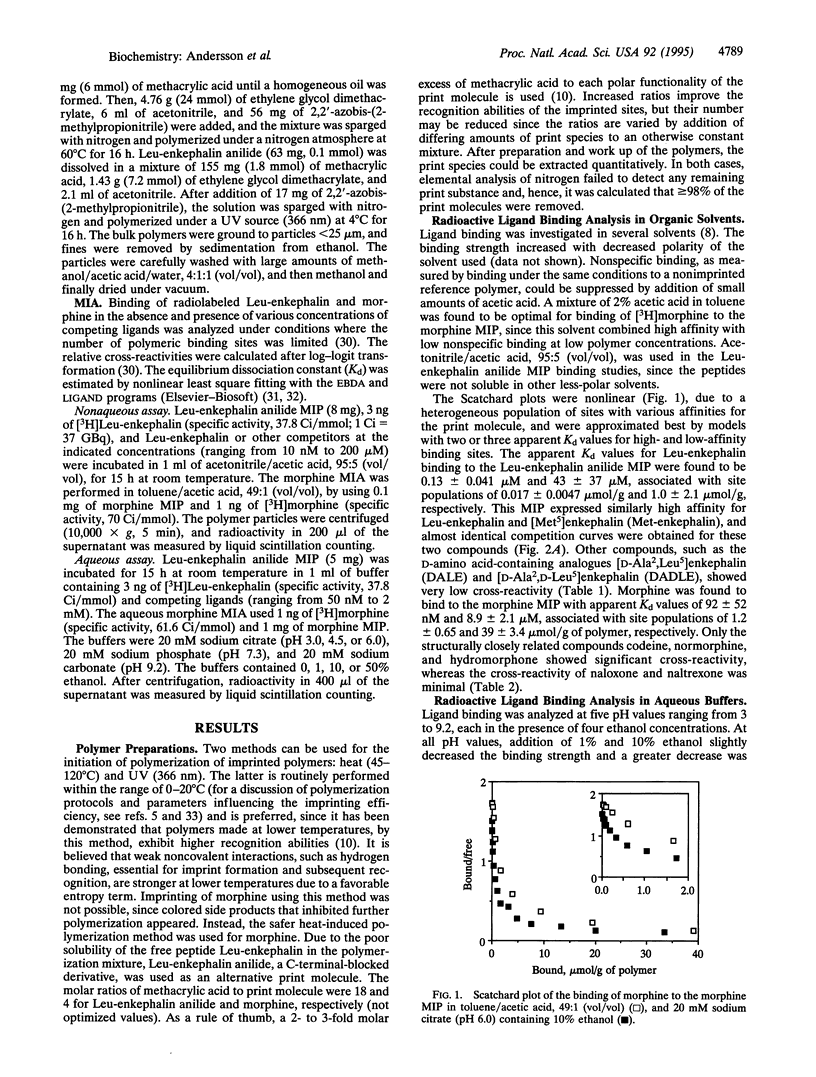
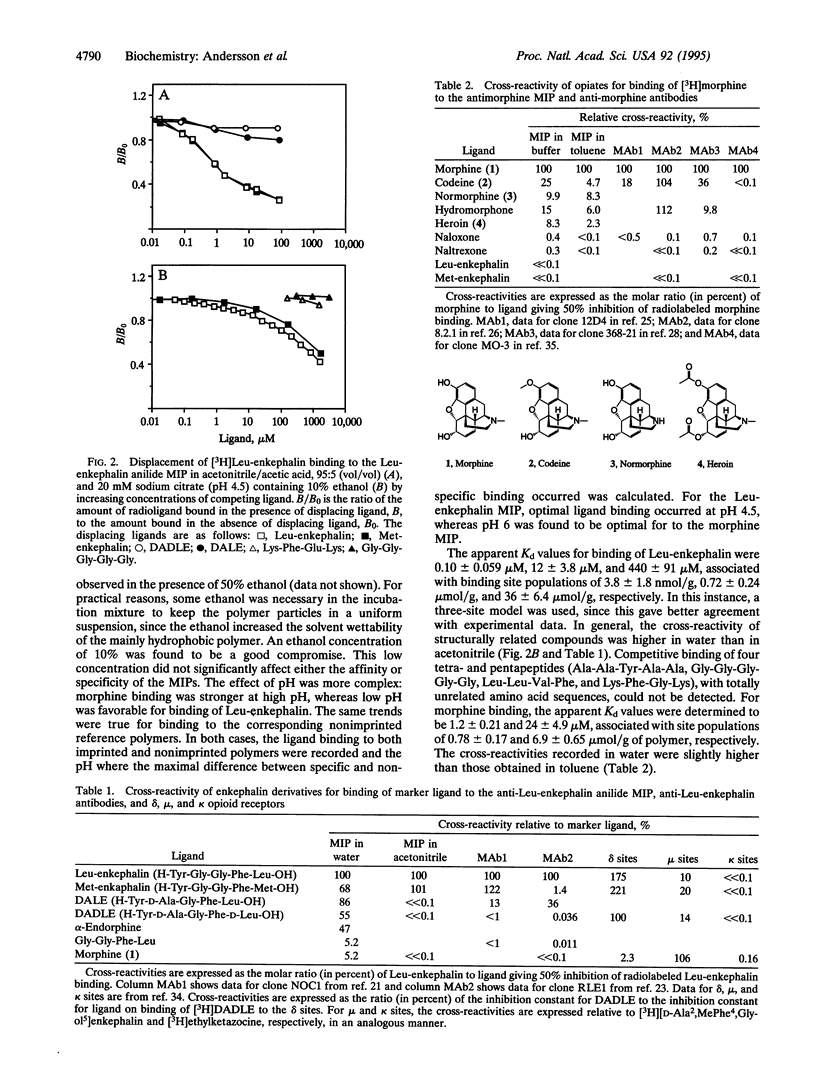
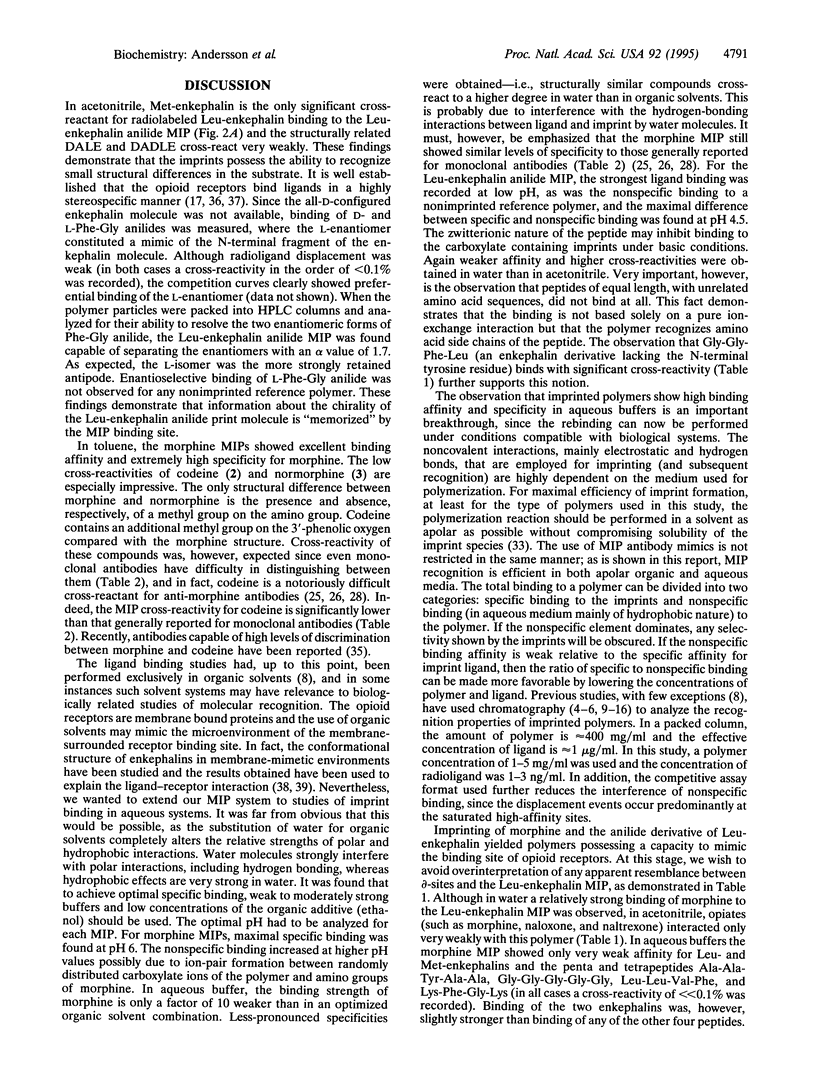
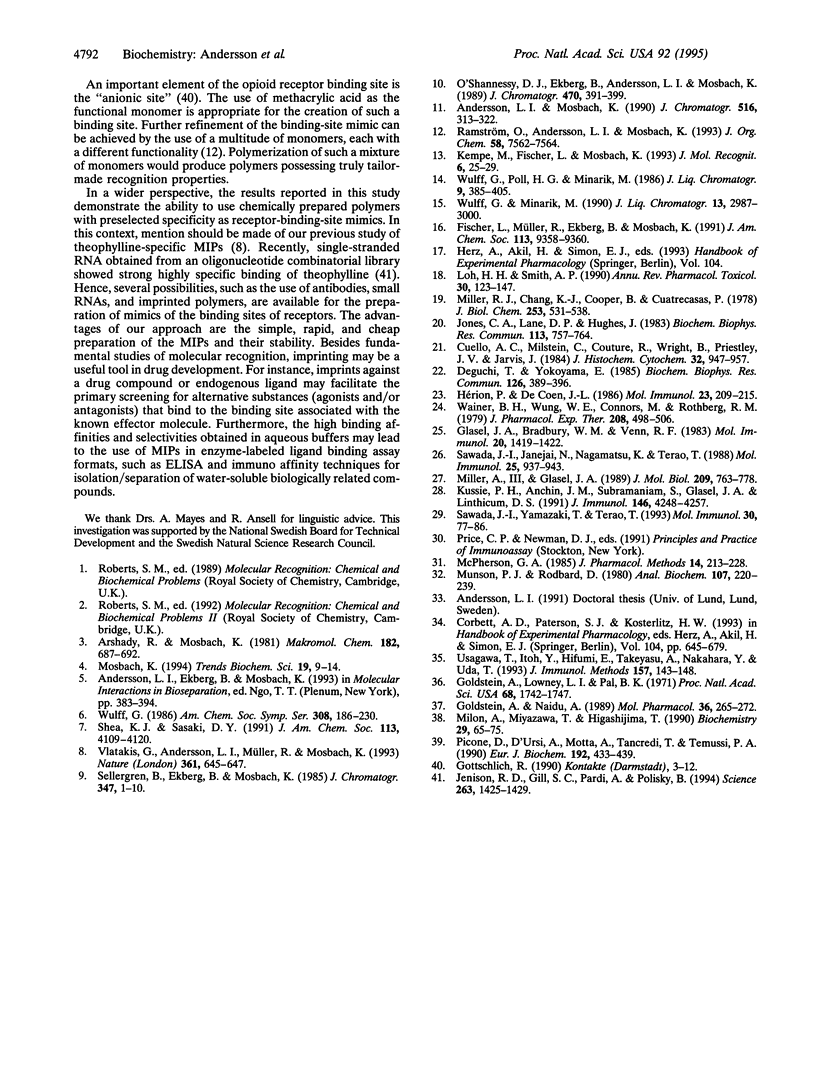
Selected References
These references are in PubMed. This may not be the complete list of references from this article.
- Andersson L. I., Mosbach K. Enantiomeric resolution on molecularly imprinted polymers prepared with only non-covalent and non-ionic interactions. J Chromatogr. 1990 Sep 21;516(2):313–322. doi: 10.1016/s0021-9673(01)89273-6. [DOI] [PubMed] [Google Scholar]
- Cuello A. C., Milstein C., Couture R., Wright B., Priestley J. V., Jarvis J. Characterization and immunocytochemical application of monoclonal antibodies against enkephalins. J Histochem Cytochem. 1984 Sep;32(9):947–957. doi: 10.1177/32.9.6086744. [DOI] [PubMed] [Google Scholar]
- Deguchi T., Yokoyama E. Monoclonal antibody to enkephalins with binding characteristics similar to opiate receptor. Biochem Biophys Res Commun. 1985 Jan 16;126(1):389–396. doi: 10.1016/0006-291x(85)90618-7. [DOI] [PubMed] [Google Scholar]
- Glasel J. A., Bradbury W. M., Venn R. F. Properties of murine anti-morphine antibodies. Mol Immunol. 1983 Dec;20(12):1419–1422. doi: 10.1016/0161-5890(83)90175-x. [DOI] [PubMed] [Google Scholar]
- Goldstein A., Lowney L. I., Pal B. K. Stereospecific and nonspecific interactions of the morphine congener levorphanol in subcellular fractions of mouse brain. Proc Natl Acad Sci U S A. 1971 Aug;68(8):1742–1747. doi: 10.1073/pnas.68.8.1742. [DOI] [PMC free article] [PubMed] [Google Scholar]
- Goldstein A., Naidu A. Multiple opioid receptors: ligand selectivity profiles and binding site signatures. Mol Pharmacol. 1989 Aug;36(2):265–272. [PubMed] [Google Scholar]
- Jenison R. D., Gill S. C., Pardi A., Polisky B. High-resolution molecular discrimination by RNA. Science. 1994 Mar 11;263(5152):1425–1429. doi: 10.1126/science.7510417. [DOI] [PubMed] [Google Scholar]
- Jones C. A., Lane D. P., Hughes J. Monoclonal antibodies to leucine enkephalin. Biochem Biophys Res Commun. 1983 Jun 29;113(3):757–764. doi: 10.1016/0006-291x(83)91064-1. [DOI] [PubMed] [Google Scholar]
- Kempe M., Fischer L., Mosbach K. Chiral separation using molecularly imprinted heteroaromatic polymers. J Mol Recognit. 1993 Mar;6(1):25–29. doi: 10.1002/jmr.300060103. [DOI] [PubMed] [Google Scholar]
- Kussie P. H., Anchin J. M., Subramaniam S., Glasel J. A., Linthicum D. S. Analysis of the binding site architecture of monoclonal antibodies to morphine by using competitive ligand binding and molecular modeling. J Immunol. 1991 Jun 15;146(12):4248–4257. [PubMed] [Google Scholar]
- Loh H. H., Smith A. P. Molecular characterization of opioid receptors. Annu Rev Pharmacol Toxicol. 1990;30:123–147. doi: 10.1146/annurev.pa.30.040190.001011. [DOI] [PubMed] [Google Scholar]
- Miller R. J., Chang K. J., Cooper B., Cuatrecasas P. Radioimmunoassay and characterization of enkephalins in rat tissues. J Biol Chem. 1978 Jan 25;253(2):531–538. [PubMed] [Google Scholar]
- Milon A., Miyazawa T., Higashijima T. Transferred nuclear Overhauser effect analyses of membrane-bound enkephalin analogues by 1H nuclear magnetic resonance: correlation between activities and membrane-bound conformations. Biochemistry. 1990 Jan 9;29(1):65–75. doi: 10.1021/bi00453a009. [DOI] [PubMed] [Google Scholar]
- Mosbach K. Molecular imprinting. Trends Biochem Sci. 1994 Jan;19(1):9–14. doi: 10.1016/0968-0004(94)90166-x. [DOI] [PubMed] [Google Scholar]
- Munson P. J., Rodbard D. Ligand: a versatile computerized approach for characterization of ligand-binding systems. Anal Biochem. 1980 Sep 1;107(1):220–239. doi: 10.1016/0003-2697(80)90515-1. [DOI] [PubMed] [Google Scholar]
- Picone D., D'Ursi A., Motta A., Tancredi T., Temussi P. A. Conformational preferences of [Leu5]enkephalin in biomimetic media. Investigation by 1H NMR. Eur J Biochem. 1990 Sep 11;192(2):433–439. doi: 10.1111/j.1432-1033.1990.tb19245.x. [DOI] [PubMed] [Google Scholar]
- Sawada J., Janejai N., Nagamatsu K., Terao T. Production and characterization of high-affinity monoclonal antibodies against morphine. Mol Immunol. 1988 Sep;25(9):937–943. doi: 10.1016/0161-5890(88)90133-2. [DOI] [PubMed] [Google Scholar]
- Sawada J., Yamazaki T., Terao T. Molecular and biochemical analyses of combining sites of monoclonal anti-morphine antibodies. Mol Immunol. 1993 Jan;30(1):77–86. doi: 10.1016/0161-5890(93)90428-e. [DOI] [PubMed] [Google Scholar]
- Vlatakis G., Andersson L. I., Müller R., Mosbach K. Drug assay using antibody mimics made by molecular imprinting. Nature. 1993 Feb 18;361(6413):645–647. doi: 10.1038/361645a0. [DOI] [PubMed] [Google Scholar]
- Wainer B. H., Wung W. E., Connors M., Rothberg R. M. The specificity of antimorphine and antimeperidine antibodies and their reactivity with opioid peptides. J Pharmacol Exp Ther. 1979 Mar;208(3):498–506. [PubMed] [Google Scholar]


